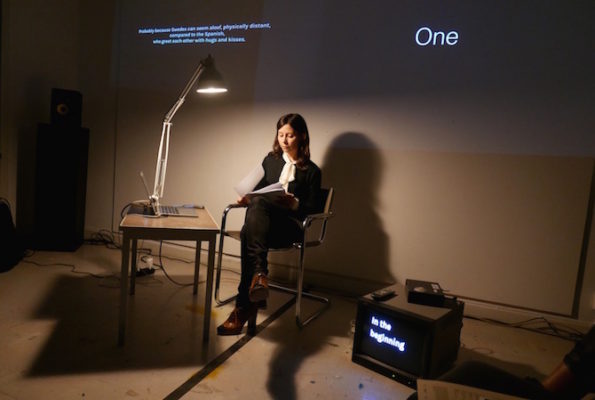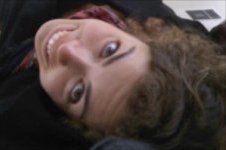Search
To search for an exact match, type the word or phrase you want in quotation marks.
A*DESK has been offering since 2002 contents about criticism and contemporary art. A*DESK has become consolidated thanks to all those who have believed in the project, all those who have followed us, debating, participating and collaborating. Many people have collaborated with A*DESK, and continue to do so. Their efforts, knowledge and belief in the project are what make it grow internationally. At A*DESK we have also generated work for over one hundred professionals in culture, from small collaborations with reviews and classes, to more prolonged and intense collaborations.
At A*DESK we believe in the need for free and universal access to culture and knowledge. We want to carry on being independent, remaining open to more ideas and opinions. If you believe in A*DESK, we need your backing to be able to continue. You can now participate in the project by supporting it. You can choose how much you want to contribute to the project.
You can decide how much you want to bring to the project.

To describe a narrated exhibition in which the works become present through their oral description could seem like a weighty postmodern game, but it is what I propose to do in this text. Last 1st June the curator Alexandra Laudo [Heroines of Culture] presented a work fruit of her research within the framework of the CuratorLab at the university of Konstfack, Stockholm. An Intellectual History of the Clock was presented in the residency for artists and curators at the Nordiska Konstförbundet (the Nordic art association), a two-storey house located in the district famed to be the coolest in the city, Södermalm.
The event began with the notice from one her helpers to the small group of us united in front of the house that we could enter. We had to do so through the kitchen, traversing a room that housed a work, to reach a room where the performed talk or performative lecture would take place.
In the kitchen, a variety of foodstuffs were laid out on a table: tofu, meat, peppers, and other vegetables. Each one had a sort of label indicating the time its preparation would take, or the thickness of the slices into which it should be cut. A piece by Gideonsson/Londré was located in the next room that consisted of a rectangular prism with a wooden cover that housed in its interior a woofer that made the whole structure vibrate with a monotonous relaxing rhythm. According to what Alexandra later recounted, the woofer was connected by WIFI to the atomic clock of the Swedish national time scale UTC(SP). Some of us stood on top of the cube to feel its pulsations in our body. Bio-politics embodied.
The room where we could finally sit down was divided in half by a line marked on the floor which we later understood represented the time zone prevalent in one zone of the Pacific; a totally irregular line that evidences how at present the different time zones are partly fruit of a sum of human interests – as is the case of the Spanish peninsula, the time zone for which was imposed by Francisco Franco in 1942. This line divided the chairs giving the room an ecclesiastical feel. At the back of the room, Alexandra was located right beside a table, where, on a Mac she flipped through the images that illustrated her narration.
The conference lasted for around an hour and twenty minutes. The explanation of different mechanisms used throughout history to measure time was interspersed with descriptions of various works of art related to this subject. Being an exhibition based on time, I find it impossible to return to it other than by perishable memory, hence why I can’t remember all the names of the artists. I do remember Cecilia Hultman, Pedro Torres, and John Cage. Up to this point, we could say that the literary recourse most used was ekphrasis or the realistic and precise description of a work of art.
But this talk also had its dose of hypotyposis, or a more lively and personal description of a work of art, that alternated with the ekphrasis. The screen onto which the images were projected was divided into two; with, on one side, images that endorsed ekphrasis and on the other, hypotyposis, with subtitles in English of the Spanish audio of the voice of Alexandra in which she narrated her experience of attending the space [Andquestionmark, in Stockholm, where a few months before Gideonsson/Londré developed ‘The Hour of the Wolf’.
In addition, the exposition was interrupted on three occasions. The first time (or was it the second?) a girl who showed us some ballet steps while on the screen we could see some calculations made with a compass. The second, by the cooks who offered us a snack with the foodstuffs we’d observed on entering; and the third, when the lights were turned off and we had to read by the light of our mobile phones a short text about a mega project, that was never carried out, to harness sunlight to illuminate isolated zones of Siberia. Was this really conceived? Or did the curator invent it?
It raises the question of the curator. Can one talk from a personal perspective, should it be allowed? Or, on the contrary, should her work be based on an objective study that transmits the message of the works in the most faithful manner possible? Representation is precisely this: re-presentation. I don’t believe objective curating is possible. Even in ekphrasis decisions are constantly being made: to describe this or another aspect of this work? In what tone? And finally, why this work?
An Intellectual History of the Clock, as the curator Camilla Larsson said after the exposition, is a much more physical experience than other exhibitions where we have to move through a room. Even though images haven’t been totally avoided, just the original works (apart from that of Gideonsson/Londré), it is stimulating to see a work of curatorship so well crafted without practically having to move from one’s chair, as if you were watching a piece of theatre, but one where the images are insinuated rather than explicit. The eroticism of the imagination. I won’t linger on all the stylistic aspects of the exposition (the projector was on a structure on the wall so as not to obstruct the space of the chairs, the images in black and white, like the curator’s outfit, the placement of the lights, the music used in key moments, etc.) I will just say that these details facilitated the sensation of travelling through time and space from the comfort of one’s seat.
There are those who say that lately there is an excess of performative art or an excessive use of the term. As the historian Dorothea von Hantelmann says, performative art doesn’t exist as no art exists that isn’t performative – in the original sense of the term coined by John L. Austin in How to Do Things with Words or by Judith Butler. In this sense, all work is performative in as much as it produces a certain reality. On the other hand, the category of performative art used since the 60s and in crescendo alludes to that art which pretends to create a physical experience in the body of the public/spectator. What consequences does the fact that experience is orchestrated and transmitted from the start to finish by a curator and not by an artist have on the message the public/spectator receives?
Rosalind Krauss says that art based in experience is timeless as its reference is the actual space where the body is situated rather than a historic space. Nevertheless, since the Minimal Art to which Krauss referred, we’ve seen innumerable examples in which art based in experience includes historic references. In An Intellectual History of the Clock the curator contributes this very historic context to the works as part of the ekphrasis. Nonetheless, the elements that make the talk more subjective (the description of ‘The Hour of the Wolf’ and the theatricality) make the public/spectator doubt the veracity of the data provided by the curator. The public/spectator is confronted not so much with their spatial or temporal situation, as with something more important, their capacity to submit to a discourse.

Raquel Machtus is a nomad by birth. Aside from her enthusiasm for discovering new places in the world, she is also interested in nomadism in situ, that is to say exploring and going deeper into the as yet not established connections between elements within a context. In addition, she thinks that art, analysed through all its facets, offers very interesting perspectives on this nomadism. She’s proposing to go into them in more depth.
"A desk is a dangerous place from which to watch the world" (John Le Carré)